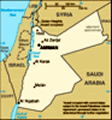Advertisement
We are exhausted after a very long and tiring day yesterday so we sleep in for a long time. We awake to see the view of the Dead Sea from our balcony in daylight for the first time. It is spectacular, with the morning sun shining on the hills of Palestine and Israel in the distance on the opposite bank. I go for a wander, and watch people swimming from the beach below me. Actually they don’t seem to be swimming at all; floating on their backs just above the surface would be a better description. Anyone who tries to swim face down seems to get involuntarily flipped over within a few strokes. I‘m itching for us to try this.
The breakfast buffet includes something called “foul”. Whilst this sounds about as appetising as yesterday’s buffet at Petra we read that it is a very popular traditional Jordanian dish of fava beans, olive oil and spices, and it’s been around in these parts for thousands of years.
We spend most of the day asleep by the pool in front of our room, before heading down for our obligatory dip in the Dead Sea. Issy says she’s read that the
preferred routine is to go in for ten minutes, come out and cake yourself in black mud, wait ten minutes for the mud to dry, and then go back in again and wash the mud off. I decide to skip some of these steps. The buoyancy is ridiculous. Once the water gets much above waist level it‘s not possible to stand up any more; you float automatically. As I suspected from watching others from a distance earlier, it is also impossible to swim face down, you just get flipped over onto your back whether you like it or not. I wonder if anyone’s ever drowned here; I think that might also be impossible. The “lifeguard” seems far more intent on showing attractive young ladies the mud routine than keeping an eye out for struggling bathers. Heaven help anyone who goes in here with any cuts or sores. I’ve got a couple of minor scratches on my legs from falling on some rocks out in the desert a couple of days ago. I was scarcely aware they were there before, but now they feel like I suspect wounds would feel if you’d been bitten by a shark. Issy accidentally splashes a
few drops of water in her eyes. It stings so much she can’t see anything and I have to hold her hand and lead her up onto the beach. And the taste. I lick one of my fingers; pure salt doesn’t taste this salty. Issy gets out and scoops handfuls of black mud from a large urn near the shore, and smears it all over herself. She waits a few minutes for it to dry and then wades back in again so she can wash it all off. I’m not quite sure why this is supposed to perform miracles for your skin, but if the number of people performing this ritual is anything to go by then there must be something to it.
The Dead Sea is aptly named. We read that it’s more than 34% salt, so nearly ten times saltier than the sea, and it‘s too salty to support any plant or animal life. It’s over 300 metres deep, which apparently makes it the deepest hypersaline lake on the planet. It is however receding at a rather alarming rate. Its surface area has decreased by 40% since 1930 and its depth has reduced by forty metres. A
number of proposals are in place to try to alleviate this, the most prominent of which is a Jordanian plan to pump water in from the Red Sea, desalinate it to provide potable water to Israel, Palestine and Jordan, and then use the waste from the desalination process to top up the Dead Sea.
We drive up to Mount Nebo in the late afternoon, and visit what is known locally as The Memorial to the Prophet Moses. Moses is said to have seen the Promised Land from Mount Nebo and is supposedly buried here, although no one knows exactly where. The mountain is around 700 metres above sea level, so is a steep climb up from the Dead Sea‘s 400 metres below sea level. The main structure on the site is a small modern church housing mosaics from the remains of a fourth century Byzantine Church and monastery which were discovered here in the 1930s. Apparently you can see Jericho and Jerusalem from up here on a clear day, but it’s hazy today.
We have dinner on a terrace next to a pool high on the hill overlooking the Dead Sea. The setting is idyllic. We‘re sitting less
than a metre from the pool’s edge, and we’ve had a few drinks, so extra care is required to avoid embarrassing accidents.
Advertisement
Tot: 0.071s; Tpl: 0.013s; cc: 13; qc: 27; dbt: 0.0362s; 1; m:domysql w:travelblog (10.17.0.13); sld: 1;
; mem: 1.1mb











D MJ Binkley
Dave and Merry Jo Binkley
Jordan
Always a good float in the Dead Sea.